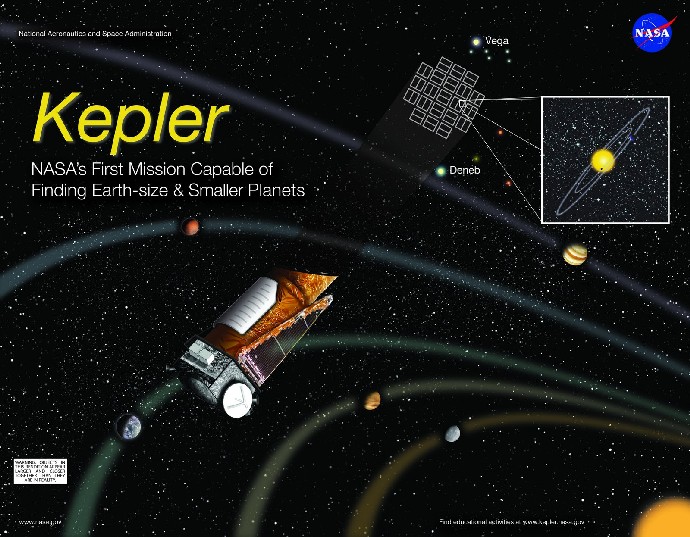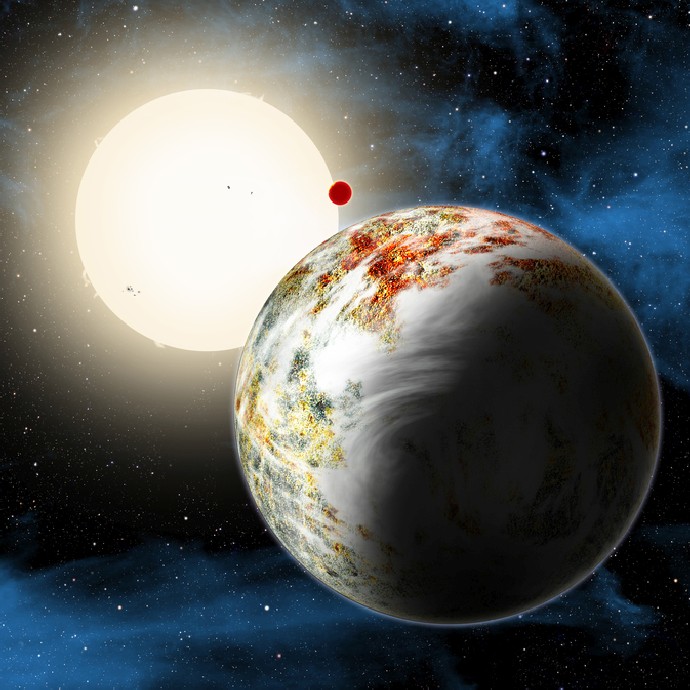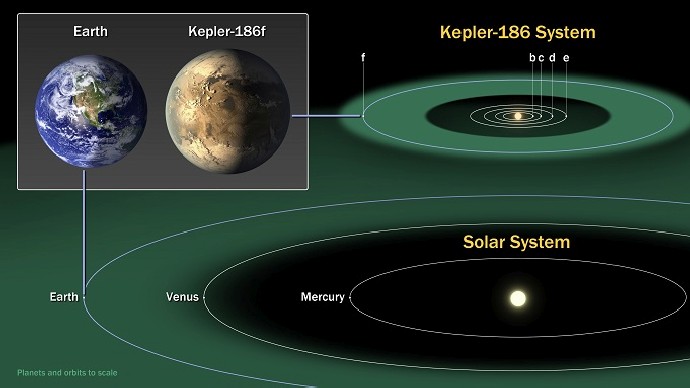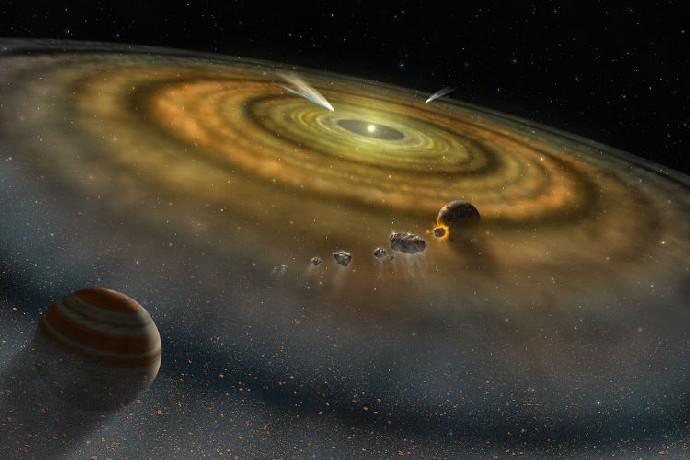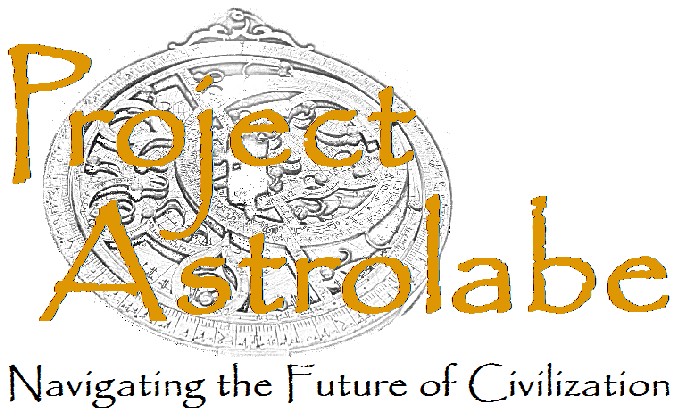 [logo for Project Astrolabe by J. N. Nielsen]
[logo for Project Astrolabe by J. N. Nielsen]
Project Astrolabe: Navigating the Future of Civilization
J. N. Nielsen
Introducing Project Astrolabe
Icarus Interstellar will be adding Project Astrolabe to its programs, which will be concerned with the core issues of civilization’s evolution, longevity, and existential risk. It will be the purpose of Project Astrolabe to bring to the study of civilization in the universe the same active engagement that Icarus Interstellar brings to the design of interstellar spacecraft, and in so doing to shed light on the place of human civilization in the universe.
Carl Sagan wrote that, “…every surviving civilization is obliged to become spacefaring — not because of exploratory or romantic zeal, but for the most practical reason imaginable: staying alive.” (Pale Blue Dot: A Vision of the Human Future in Space, Chap. 21) This insight shows us the close connection between interstellar travel and the future of civilization. Moreover, the high technology civilization that will make interstellar travel possible and which will therefore provide a further futurity for civilization will force that same civilization to confront a range of challenges, including the degree to which our technology transforms the lives of human beings, the architects of civilization.
Finding an Earth twin
Considerable light would be shed on our own civilization and its future course of development if we knew that any other civilization had already made the transition to a viable spacefaring civilization capable of assuring its own ongoing future. Any civilization sufficiently like us that there is a reasonable hope of communicating with its architects must originate, as we have, on the surface of a naturally occurring celestial body, whether a planet or a moon or some other environment we have not yet anticipated but which might also be clement to the development of life. To find a peer civilization, then, it is a natural response to seek the closest instance of a peer of our Earth – an Earth twin, as it is usually called.
The search for exoplanets is allowing us for the first time to begin to quantify a few of the variables involved in determining the relative abundance or rarity of life in the universe: the number of stars with planets, the number of planetary systems with small, rocky planets, and the number of small, rocky planets in the habitable zones of their stars. Many further variables remain that cannot yet be quantified by contemporary science, although as our techniques become more sophisticated and our instrumentation becomes more sensitive, more of these variables will begin to take on values based on empirical evidence.
Planetary science is in its infancy, and growing rapidly. NASA’s Kepler mission, in particular, was designed to find exoplanets, and its successes to date have greatly expanded our knowledge of exoplanetary systems. It has also afforded us surprises. Most recently, the Kepler space telescope has discovered a dense, rocky planet larger than expected for a planet that is not a gas giant (cf. Astronomers Confounded By Massive Rocky World and my comments on this), which may be an occasion for the revision of theories of planetary formation. Whereas before we had no basis of comparison in the form of other planetary systems, we now have a growing body of knowledge that concerns other planetary systems. We can expect that the life sciences also will be forced into rapid development if we are able to discover exobiology to compare with terrestrial biology.
[An artist’s conception of Kepler-10c; Image Credit: Harvard-Smithsonian Center for Astrophysics/David Aguilar]
Planetary systems now seem to be very common. There is evidence that there is at least one planet in the Alpha Centauri system, notwithstanding the gravitational complexity of a triple star system, and there are planets orbiting Tau Ceti, a relatively nearby sun-like star, which was one of the objects of the first SETI study, Project OZMA, during the course of which Frank Drake listened for radio signals from Tau Ceti. Now we know there is a planet there, although we have not received any signals from it.
As the search for exoplanets progresses with more sophisticated techniques and more sensitive instrumentation, we not only add to the steadily growing inventory of exoplanets, but we come ever closer to finding an “Earth twin” – another place in the universe that proves to be “just right” for life, as conditions proved to be on Earth. Discussions of candidates for an Earth twin, most recently provoked by the discovery of Kepler-186f (the closest we have yet found to an Earth twin), have provoked great interest, but also a degree of anxiety among those who place the discovery of Earth-like planets in the context of the Great Filter.
[Image Credit: NASA Ames/SETI Institute/JPL-Caltech Kepler-186 and the Solar System]
Why we should welcome exoplanet discoveries
In a recent article that first appeared on The Conversation, and was later widely read on Ars Technica, Andrew Snyder-Beattie asked if habitable exoplanets are bad news for humanity. The author writes that, “…this discovery also slightly increases how much credence we give to the possibility of near-term human extinction.” The reasoning being that the elimination of probability filters that lie in our past – like the existence of a planet in the habitable zone of its star – means that the probability filter for an expanding spacefaring civilization that would make its presence felt in the galaxy is more likely to lie in our future. If all the probability filters in our past are eventually eliminated, according to this line of reasoning, we would have no choice but to expect the great filter in our future.
On the io9 website there is an article that covers similar ground, Does a galaxy filled with habitable planets mean humanity is doomed? by George Dvorsky. The article by Dvorsky asserts, “…the idea that the Milky Way is teeming with rocky, habitable planets blows the Rare Earth Hypothesis right out of the water.” This is not an accurate claim. There is much more to the rare earth hypothesis than an earth-sized planet in a habitable zone – an atmosphere, geological activity, oceans, a magnetic field, an axial tilt to produce seasons, a large moon to stabilize the orbit and rotation, and another large planet in the outer solar system to clear away the debris and lessen the likelihood of collisions all are part of what makes Earth an “ecological planet” (as John Kricher calls the Earth). Some of these variables we will eventually be able to determine by long-distance observations, but some of the more subtle features of a life-bearing planet will require closer inspection. We will have to go there to understand more fully what makes a planet fertile or barren.
Planetary systems form from a protoplanetary disk surrounding a young star. We should expect there to be almost as many planetary systems as there are stars, because the formation of a star is likely to leave a proto-planetary disc (though the complex gravitational interactions of multi-star systems may interfere with planet formation, and, as noted above, we may still have to revise our theories of planet formation). Among planetary systems, some percentage will result in small rocky planets orbiting in a circumstellar habitable zone (CHZ). Of these, some percent will have an atmosphere. Of these, some percent will be geologically active. Of these, some percent will have enough water to form oceans, and so on. We will have to sort through a lot of Earth “twins” the like of Kepler-186f before we find another planet as suitable for life as Earth. Thus we see that the rare Earth hypothesis has been in no sense blown out of the water by the discovery of Kepler-186f and similar exoplanets. This is one reason to welcome exoplanet discoveries: we will need a lot of them to further quantify potentially life-bearing planets.
[A rendition of Beta Pictoris’ protoplanetary disk and comet cloud Image credit: NASA / FUSE / Lynette Cook http://news.softpedia.com/newsImage/Nearby-Star-Is-Surrounded-by-a-Cloud-of-Comets-2.jpg/]
Quantifying Civilization
We have known for a long time that our star is not a cosmological exception, and that there are countless more like it in the universe. We know now in addition that the Earth is not a cosmological exception, in terms of being the only small, rocky planet in the habitable zone of its star. We may soon learn that the Earth is not alone in other respects. This does not prove anything about human extinction. Even given all the right conditions, there is no guarantee that life will emerge from a habitable planet, that life will grow complex, or that consciousness, intelligence, and civilization will be forthcoming if only we wait long enough. We cannot even begin to quantify the distribution of civilization in the universe until we can document multiple independent instances of civilization (or the absence thereof), not to mention multiple independent instances of life in the universe. It would be intellectually irresponsible to suggest otherwise; the evidence is not yet in.
At the present stage of our knowledge, and with planetary systems appearing to be as common as stars, there is no more reason to link the number of technological civilizations in the galaxy with the number of exoplanets than to link this number to the number of stars, because there is nothing inevitable about the unfolding of the kind of historical processes that give rise to civilization. And if there is nothing necessary or inevitable about the unfolding of historical processes, the historical process that we now call the great filter should inspire us with no fear of being inevitably crushed by some inexplicable mechanism that selects against civilization.
The more that which is peculiar to human history (and to the emergence of the kind of civilization that we have today) is an historical anomaly, and the other factors that enter into the emergence of life are not unique, the more reason we have to believe that the great filter lies in our past – specifically, in the development of our technological civilization – and we alone have survived to tell the tale of becoming a spacefaring species. So I welcome the many announcements of habitable exoplanets, as I will welcome future announcements of exoplanet atmospheres with biosignatures, all the while knowing that no civilization has grown to the extent of making a noticeable dent in the universe.
The evidence simply is not yet in whether the great filter lies in our past or in our future. Indeed, the evidence is not yet in that there is any single “great” filter at all rather than a sequence of lesser filters that together add up to the same effect as a single great filter (a sequence in which we may well be embedded at present). The argument can be made either way, that is, that the great filter lies in our past and we are in the clear, or that the great filter lies yet in our future, and we have yet to face the sternest challenge of our existence, but there is no empirical evidence to confirm or disconfirm either conclusion. Carl Sagan often made the point that it’s okay to reserve judgment until the evidence is in. This is certainly one of those instances in which we would want to reserve judgment.
A Sobering Responsibility
I find the existence of exoplanets a sobering reality, but not a source of any anxiety over human extinction. From the mere existence of Earth-like planets found in the habitable zones of stars we can conclude nothing about our temporal position relative to the great filter. The narrowing of the conditions of spacefaring civilization to the contingent events of human history by the discovery more and more of the conditions necessary to life being relatively common means that we can safely attribute our own status as a rudimentary spacefaring civilization to the accidents of our own development. And, having passed through those unlikely stages of development, a great career awaits us in the universe in which other species like ourselves are rare.
If the great filter lies in our past, then we are among the rarest of the rare beings in the universe, having passed through the great filter that has prevented most life in the universe from reaching the level of development achieved on Earth. In this case, our rarity imposes upon us a special obligation to serve as responsible stewards of the unique treasure that is our world and ourselves. We must ensure that the light we have lit is not allowed to go out, but is rather the torch from which other torches in a great relay can be lit in turn, as we expand beyond our home in the solar system into a galaxy and a universe rendered nearly sterile by the great filter.
If, on the other hand, the great filter lies yet in our future, it is incumbent upon us to bend every effort to prepare ourselves for the trial we have yet to face. If no other species, or very few other species in the universe, have successfully passed through a great filter that lies yet in our future, that is a reason for hope and not despair. We are not abandoned to fate, but we have a role to play in meeting the challenge that we now have the foresight to anticipate, and for which we can make ourselves ready. Either state of affairs – the great filter in our past or our future – confers upon us a sobering responsibility; I look forward with considerable anticipation to either possibility.
What’s next?
The next obvious steps for determining our place within the cosmos – currently within our technological capability, but not being pursued for lack of funding – are larger and more sophisticated telescopes in space. A next generation space telescope may have the ability to get spectroscopic readings of the atmospheres of exoplanets, with could reveal biosignatures and possibly also what might be called technosignatures (if, for example, we could detect industrial pollutants in an exoplanet’s atmosphere). A very large radio telescope erected in space, purpose-built for eavesdropping on other civilizations, might be able to detect the passive EM spectrum emissions of a civilization innocently transmitting, but not with sufficient power to be easily detected (as we have been radiating for a hundred years). Another mission of existential importance would be to visit Jupiter’s moon Europa to sample its sub-cryosphere oceans for life, as any evidence of an independent origin for life would have much to teach us. These are potentially exciting projects with exciting findings that make me eager and not anxious for the future.
Another obvious step is that being debated in respect to SETI (search for extraterrestrial intelligence) and METI (messaging interstellar intelligence). If we really want to quantify signs of technological civilization in the universe, we need to think about how SETI and METI programs are or will be integral to any interstellar effort, as both are about the quest for knowledge as an active engagement with the world.
In parallel with these efforts, we will want to study the technological trends emerging from our rapidly changing civilization, for what they portend for the future. What technologies our science develops for us, and which among these technologies prove to be practicable and adaptable to the peculiar architecture of our civilization, will shape every detail of the future, and may prove the difference between human civilization being viable or non-viable. Every particular interstellar propulsion technology, or life sciences technology, or computing technology – everything, in short, that goes toward building a technological civilization – interacts differently with the individual life making use of such technologies and the socioeconomic structure within which the individual finds a home.
The study of the future of civilization, then, requires that we engage with questions of detail in regard to the particular means of securing our long-term future, as well as engaging with the big picture of difficult issues that will be posed by future developments, such as the economics of spacefaring civilization, transhumanism, computational infrastructure, and the profound moral dilemmas of expanding the terrestrial biosphere and human civilization beyond Earth.
-
Nick Nielsen will lead Project Astrolabe in these investigations, with Heath Rezabek as Deputy Project Lead. You can read the Project Astrolabe Project Proposal Outline here.
If you’re interested in joining the study team, please email info@icarusinterstellar.org with a short statement of interest and brief background information. We are looking for people with interest and/or experience in anthropology, sociology, transhumanism, futurism and other disciplines relating to assessing the past and future of social and technical evolution and thought.
